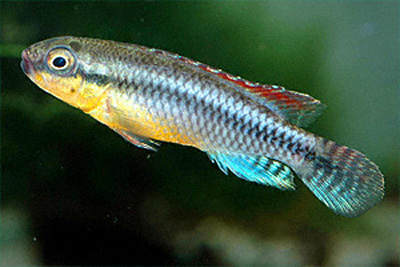| Cichlidae (Cichlids), subfamily: Pseudocrenilabrinae |
| 6.2 cm TL (male/unsexed) |
|
demersal; freshwater; pH range: 6 - 7; dH range: 5 - 8, |
| Africa: middle Congo River basin in Central African Republic (Ref. 45441), Republic of Congo (Ref. 53209) and Democratic Republic of the Congo (Ref. 41580, 41591, 45441, 106245, 106290). Also in the upper Chari (Chad basin) in Central African Republic (Ref. 47441, 52070). Reports from Gabon and Cameroon refer to Parananochromis brevirostris (Ref. 81260). |
|
Dorsal spines (total): 17-17; Dorsal soft rays (total): 7-7; Anal soft rays: 6-6; Vertebrae: 25-25. Description: body elongated; snout and caudal fin rounded in both sexes; females smaller than males and possess shorter dorsal, anal and pelvic fin rays; pelvic fins always slightly rounded in females, always pointed in males (Ref. 52307). Hypurals 3 and 4 fused with the urostyle; hypurals 1 and 2 remain autogenous (Ref. 72415).
Coloration: body grayish to brownish in most specimens, although reddish patterns may be present (most often in dorsal and anal fins) in certain populations. Depending on behavioural situation, 2 dark longitudinal stripes may be visible on the body (especially in submissive and non-territorial specimens, but also in breeding ones); these stripes sometimes irregular, forming 2 rows of dark blotches; females with broad silvery to white band in dorsal fin, absent or very thin in males; ripe females with orange belly; in males, entire caudal and soft dorsal and anal fin with pale dots (Ref. 52307). |
| Known from larger rivers and lakes (Ref. 72415). Pair-bonding, biparental, cave-spawning species (Ref. 52307). |
|
Least Concern (LC); Date assessed: 14 August 2019 Ref. (130435)
|
| harmless |
|
Source and more info: www.fishbase.org. For personal, classroom, and other internal use only. Not for publication.

